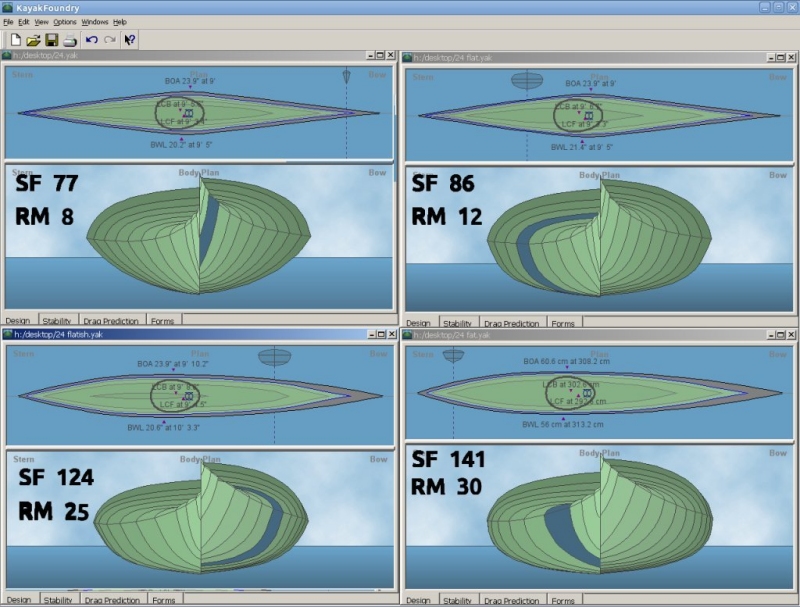I hear all the time. People want a 24 inch wide boat because it will be stable. Or they are trying one of my 22 inch wide boats and instantly assume it isn’t going to be stable. Just like they assume longer is always faster.
Fact is that width of kayak is virtually meaningless. There are many factors that effect the stability of a kayak and width is but one and not by any means a good indicator. Yes, most commercial kayak that are 24″ side probably are pretty stable. But it is not because of the width, but the shape of the hull.
Recently Allan Newhouse of Tuross Head, NSW, Australia posted Blue Heron Kayak forum an excellent study on this. It was so good I asked Allan for permission to use it on my web site. Even I was a bit surprised by the results. The variation was greater than I expected.
The ONLY thing I will add is an explanation. RM is the right moment and SF is the Stabiity Factor.
The following stability numbers come from the formula Steve Killing developed to compare different boat. The simplicity of Steve’s numbers make it easier to compare boats. Keep in mind that everyone will have a different level of comfort.
From what I have gathered reading:
110+ is comfortable for all novices
100 is comfortable for most paddlers
98 will be initially tender to some novices, but after a few paddles will be quite comfortable
92 is not comfortable to most novices.
88 is a challenging boat for some people to paddle
40 to 50 is the low end, a K1 racing kayak would be somewhere in that range.
Now, Allen’s post:
The width of a kayak is not always a good indication of how stable it will be.
I had the idea that I would produce a series of images to show how a number of factors affect stability, but quickly realized that the number of variables and combinations involved would need more images than I was prepared to create and more than anyone else would be prepared to look at.
So I have confined myself to just a few variables; the one Jeff mentioned in a recent post and a couple of my favorites.
I took the default Kayak Foundry kayak and increased the width to 24″ (for no other reason than that it was a figure Jeff mentioned in the other thread).
Without changing the width, I produced kayaks with SFs ranging from 77 to 141 with maximum righting moments ranging from 8 to 30. So it is possible for one 24″ kayak to have about four times as much force pushing you back upright from 20 to 25 degrees as another kayak exactly the same width.
The changes I made are only slightly exaggerated from some of the designs I have seen here. I did that just to make it more obvious what I had changed. Even with less extreme designs, it is easy to get enormous variations in stability.
There are other things that affect stability too. As a kayak gets longer, the stability increases, even if things like the waterline width remain the same. However incorporating all of them would have created too many permutations and combinations.
The images below are of kayaks that are all the same width, but there are huge differences in stability.

As you can plainly see width does not automatically mean the boat will be stable. There is much more to hull design than making it wider. The hull shape is much more important.




